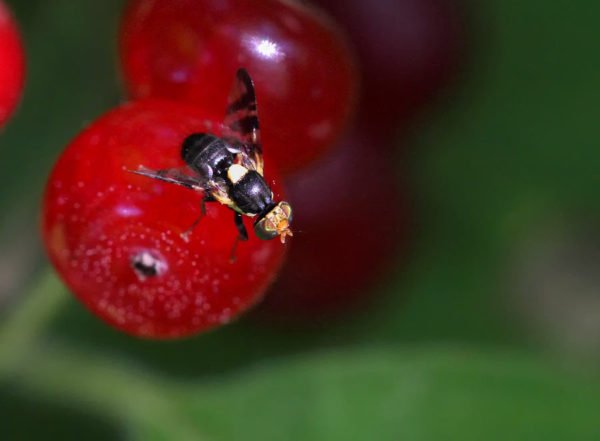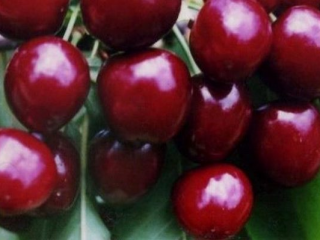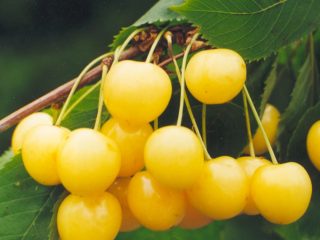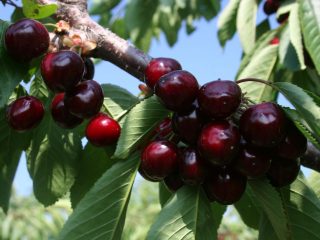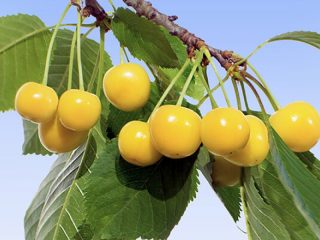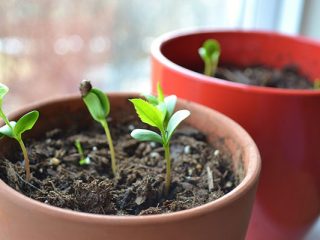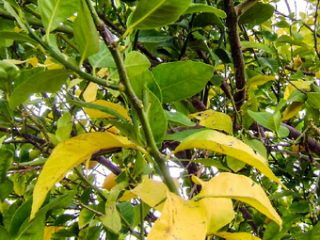Content
Cherry Tale, which belongs to the large-fruited varieties of this fruit crop, is popular among gardeners. If agricultural techniques are followed, it takes root well and allows you to get a stable harvest.
History of selection
The Skazka variety was obtained as a result of the breeding activities of scientists from the Melitopol Institute. Two varieties of cherries were used for crossing - Drogana Yellow and Valery Chkalov.
The new variety has improved many characteristics of its predecessors, the main ones being the large size of the fruits.
Description of culture
Early cherry Skazka, due to its good cold resistance, is recommended for cultivation both in the southern territories and in the conditions of central Russia.
The glossy fruits have a round, slightly elongated shape and are colored a rich garnet-red color, sometimes very dark, almost black.The homogeneous pulp with a dense juicy consistency has a pleasant sweet taste with a hint of honey. The Skazka variety is especially valuable because of its rather large size and weight of up to 12 grams. The bone is small.
The average height of the Skazka cherry tree is 3.5 – 4 meters. As it grows, it forms a dense crown with a characteristic pyramidal shape.
Oval leaf blades with sharp tops and jagged edges have a slightly wrinkled surface. Their various shades provide the tree with a high degree of decorativeness throughout the entire growing season.
Characteristics
The large-fruited Skazka cherry, being a successful result of targeted selection, has received improved characteristics of its predecessors.
Drought resistance, winter hardiness
The tree easily tolerates temperatures down to -25˚C, which makes the Skazka cherry popular in areas with unstable climatic conditions in the center of Russia.
For flowering cherries, severe night frosts can pose a danger, negatively affecting the buds.
With good indicators of drought resistance, the crop requires timely watering, which has a beneficial effect on the activation of fruiting.
Pollination, flowering period and ripening time
Since the Skazka cherry is a representative of self-sterile varieties, when breeding it, it is necessary to provide for the placement in the vicinity of varieties that can provide the pollination necessary for the formation of large berries.
Pollinators suitable for the growing season for the Skazka cherry are Tyutchevka, Ovstuzhenka, Iput.
In warm climates, flowering trees decorate the garden already in mid-April.Gardeners are attracted by such a characteristic of the Skazka cherry variety as early fruiting. Fragrant ripe berries begin to be picked from the branches in May.
Productivity, fruiting
Planted seedlings of the Skazka variety begin to bear fruit at the age of five. From young trees you can remove 5 kg of fruit.
As the fruit crop develops, the yield increases. An adult Skazka cherry plant produces an average of 30 kg of excellent large berries.
Area of application of berries
The collection of fully ripe Skazka cherries is carried out with care to avoid deformation of the juicy drupes.
They are consumed fresh, appreciating the piquant honey sweetness. They are most often prepared in the form of compotes, jams, jelly, and marmalade.
Resistance to diseases and pests
The Skazka cherry, even under unfavorable conditions with high atmospheric humidity, demonstrates good resistance to infections characteristic of this fruit crop.
This variety is rarely affected by pests, which allows for a stable annual harvest.
Advantages and disadvantages
Gardeners who have experience growing early cherries Skazka appreciate its many advantages:
- winter hardiness;
- the excellent taste of dense honey berries, distinguished by their large dimensions and spectacular dark skin with a pomegranate tint;
- fairly abundant and stable yield;
- good transportability;
- resistance of berries to cracking;
- rare damage by harmful insects and diseases.
A minor disadvantage of this fruit crop is the need to plant a number of pollinating varieties.
Landing Features
Although the Skazka cherry is considered an unpretentious crop, when planting it, it is necessary to take into account the characteristics characteristic of this variety.
Recommended timing
Saplings of early ripening cherries Skazka are planted in prepared areas after winter before sap flow. It is important to choose periods when the night temperature does not drop to below zero and the soil has warmed up sufficiently. The advantage is the ability to prepare a young tree for the winter season, so the spring planting season is recommended for central Russia.
Strong, with well-developed rhizomes, Skazka cherry seedlings successfully take root when planted in autumn in warm southern territories. They have time to adapt to new conditions and become sufficiently strong before the winter cold.
Choosing a suitable location
To grow Skazka cherries, select an elevated area that is not subject to flooding. The place should be sunny and have protection from the north.
This crop prefers fertile and loose soil. Cherry Skazka develops poorly on clay soil and poor sandy loam.
What crops can and cannot be planted next to cherries?
To ensure the predicted yield, you should carefully select the plants adjacent to the Skazka cherry.
Cherries, which can participate in the pollination process, bring undoubted benefits. Crops such as rowan and hawthorn do not hinder the development.
It is not recommended to grow raspberries or sloe next to cherries. They create unfavorable conditions for apple, plum, and pear trees. These fruit trees must be at least 6 meters away from the cherries.
Selection and preparation of planting material
Skazka cherry seedlings are carefully inspected at the acquisition stage. They should be free of signs of disease, damage to shoots and bark, and dry branches.
Trees with elastic, developed roots take root well. The buds on the branches should be well defined and dense. The vaccination site is examined. On a viable cherry seedling Skazka it is neat, without sagging or rough cracks.
On the eve of planting, if necessary, shorten the roots slightly and cut out dry shoots. The planting material is kept in a growth stimulant solution for two hours.
Landing algorithm
If you plan to plant several Skazka cherry seedlings, mark the selected area so that there is a gap of at least 3 meters between the trees.
Planting algorithm:
- Before planting cherries, planting holes with a diameter of about a meter and an average depth of 80 cm are prepared 14 days in advance.
- The excavated soil is mixed with rotted compost in equal volumes. Add the same volume of sand to heavy loam. Sandy loam is enriched with organic matter and mineral complex.
- A wooden or metal support is strengthened into the bottom. Lay the drainage and add a little soil substrate, forming a mound.
- Place the cherry seedling vertically, straightening the roots, and fill the hole with the prepared soil mixture in layers, lightly compacting them. Make sure that the root collar is above the surface.
The young tree is tied to a support with soft twine and watered.Mulch with dry humus or leaves.
Subsequent care of the crop
As part of caring for Skazka cherries, timely watering is organized at least four times during the entire growing season:
- before swelling of the kidneys;
- half a month after flowering;
- 14 days before the planned harvest;
- in early November.
Each tree requires about 10 liters of water.
Young plantings of the Skazka variety are fed with a mineral complex in April. In June, phosphorus-potassium fertilizers are applied. Loose compost is additionally added to mature trees in the fall.
Pre-winter preparation of cherries includes whitewashing skeletal twigs and trunks. Repeat it after the snow melts. To protect young cherries from freezing in the winter, plantings are laid with spruce branches. The salvation from rodents is the compaction of the snow cover around the base of the trunk.
Formative pruning with shortening of shoots by about a third is practiced annually until the buds emerge. Regular sanitary removal of dry, damaged branches is required.
Diseases and pests, methods of control and prevention
If serious violations are allowed in the organization of care, the Skazka cherry tree may experience damage from pests and diseases. In such a situation, effective measures should be taken quickly.
Characteristic diseases of Cherry Fairy Tale
Type of disease | Signs | Fighting methods | Prevention |
Clusterosporiasis | Brownish spots appear, turning into holes scattered throughout all parts of the tree. | Irrigation with a one percent solution of Bordeaux mixture. | In the spring, the crown is sprayed with Nitrafen until the buds open. |
Moniliosis | The buds dry out and the berries rot. | Treatment with a one percent solution of copper oxychloride. | In April, after flowering and harvesting the fruits, the crown is irrigated with Bordeaux mixture (0.5%). |
Coccomycosis | Brownish-red spots fill the surface of the leaf blades. | Spraying trees during the period when the entire harvest is harvested with a solution of Topaz. | Before the buds emerge, the trees are treated with Bordeaux mixture (0.5%). |
Pest control of the Skazka variety
Name | Harm caused | Pest Control |
Black cherry aphid | The larvae suck out the juice. The leaf plates are rolled up and dried. | Processing by Confidor. |
cherry fly | The larvae destroy the buds and damage the berries. | Spraying with Actellik. |
Leaf rollers | Caterpillars eat leaves. | Treatment with Chlorophos. |
Conclusion
Skazka cherries are popular due to the excellent honey taste of incredibly large, dense berries. With proper care and provision of pollinators, each tree will delight you with a fairly high yield.
Reviews
By analyzing the reviews of summer residents about the Skazka cherry, it is possible to more fully elucidate the merits of this crop.




